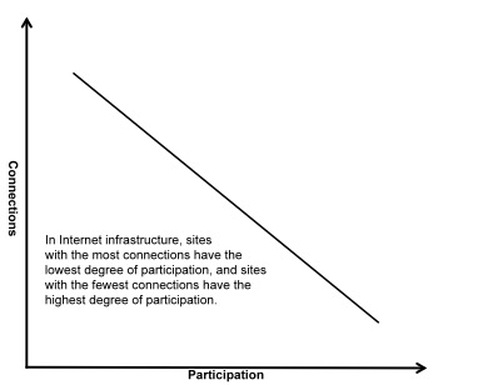In nonlinear networks, not all composed elements participate equally. For instance, the sun is composed of 71 percent hydrogen and 27 percent helium. The remaining 2 percent is comprised of a variety of elements. Elements in the final 2 percent are not equally distributed either. Oxygen is the most abundant (42.9 percent), followed by carbon (17.7 percent) and iron (9.7 percent). Various metals make up the tiny remainder.
This uneven and scale-free type of distribution is called a power law distribution. It is the most surprising characteristic of nonlinear networks. All nonlinear networks follow the power law distribution principle. In non-linear network such as the Internet, those sites with the most connections have the lowest degree of participation, and the sites that exhibit the highest degree of participation have the fewest links or connections. Take Google, Yahoo, or other large websites. There are only a few of them participating at that level, so they have the most connections with other websites. Because those few large sites have so many connections, they have more power within the network and their effectiveness to reach other websites within the network is that much stronger. But those sites that have the highest degree of participation, such as the millions of small personal websites, have the fewest connections. In nonlinear networks, the nodes with higher connectivity in the network have more power and more control.
Power law distribution applies to all nonlinear networks, including those of wealth, social power, blood circulation, the nervous system, and the natural world. Consider the Mississippi River: thousands of creeks contribute small amounts of water, but only a few large rivers contribute most of the water that forms the Mississippi River. The law applies even to written texts, where a few words such as “the” and “and” participate the most, and all the other words, which are the majority, each participate rarely and randomly.
Order And Randomness
In nonlinear networks the power law distribution also applies to order and randomness; they are mostly made of order with only a little randomness. A great example of how order and randomness can combine together to create a flexible and sustainable system is the cooperation of sympathetic and parasympathetic nervous systems to create “erratic rhythm” of our heart. The heart is really just a big muscle and would tire quickly if it performed exactly the same movement every time it pumped blood; the heart avoids fatigue by varying the speed and rate at which it clenches. This means the heart never makes the same movement from moment to moment. Movements are repeated but on such long-time scales that a healthy heart never tires. Also, the erratic heartbeat exists at the edge of chaos at a critical point, therefore like all such nonlinear systems, it will be very sensitive to small changes. As a result, it will be able to react very quickly to the demands that the body is placing on it.

Power Law Distribution of participation and connections among web sites